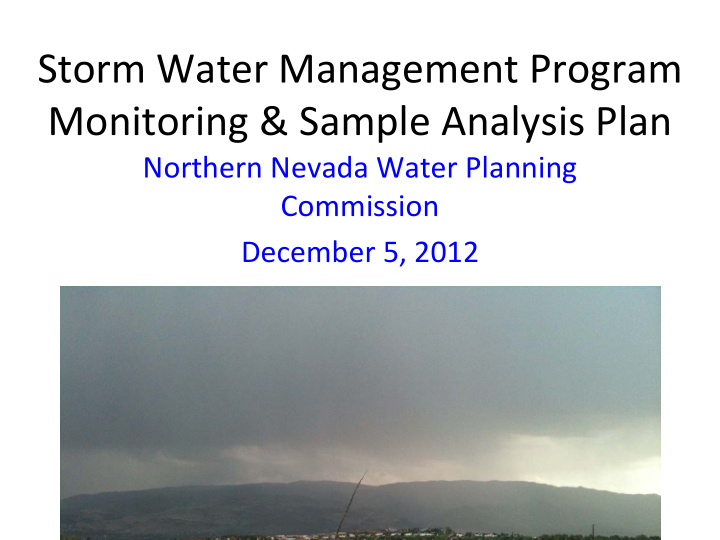



Storm Water Management Program Monitoring & Sample Analysis Plan Northern Nevada Water Planning Commission December 5, 2012
Truckee River Watershed Coordinated Monitoring Program Began: Evolved: Memorandum of Desert Research Institute Understanding (13 Funding by Truckee River groups); Fund 18 month process of Surface water monitoring sharing programmatic Benefits: information; TMWRF, SWPCC, Product: Compendium of NDEP, PLPT, Flood Truckee River Watershed Project/restoration. Monitoring programs;
Truckee River Info Gateway • Identified by NV as the clearinghouse tool for sharing program information on coordinated efforts; • TRIG: www.truckeeriverinfo.org – going to the next level… • Data housed/linked: SWPCC, NDEP, TMWA, TMWRF, WC DWR creek data, TRWC, PLPT, USGS, T-TSA, DRI/TMWRF/DEP Coordinated program efforts…
Sample Analysis Plan: a public process • Stantec was selected to assist in the development of the 2012 plan, based on 2010 permit requirements; • Public meetings and Workshop – Attended by committee members, citizens, PLPT representatives and staff; • A Consensus Model was used to develop the approach and priorities for the Plan; • Accepted by Nevada Division of Environmental Protection in November 2012, • Implementation to begin in January 2013.
Storm Water Monitoring Goals • Continuing: • Moving ahead: Characterize both Measure the background WQ & rain background & rain event WQ in the major event WQ in selected tributaries to the outfalls, catchments & Truckee. land use types. • New: Collect the data • Conduct special studies necessary to improve & investigations as the our understanding of needs arise & funding is SW effects on 303(d) & available. TMDL listings on the Truckee and its tribs.
Tributary Monitoring continue at existing locations • Semi ‐ annual sample collection (scheduled), • Rain event grab samples (wet weather), • Typically sample site selections are upstream and downstream of urbanized areas on 6 tributaries.
12 Tributary Monitoring Locations • Steamboat Ck @ • Rhodes Rd, • North Truckee Drain @ • The Narrows, • Orr Ditch, • Clean Water Way. • Kleppe Ln. • Thomas Creek @ • Whites Creek @ • Timberline Road, • Timberline Road, • S. Meadows Pkwy. • Old Virginia Hwy. • Alum Creek @ • Chalk Ck @ • Above Steamboat Ditch, • The Truckee River. • Chalk Bluff
Outfall Monitoring (10 sites) • Alum at Chrissie • Mary Wahl Ditch, Caughlin Park; • Cottonwood Park • Oxbow Nature Park; (west), • Dickerson Rd., • Greg Street (East) • Wingfield at Arlington (north side), • Wingfield / Island at • GOAL: Arlington (South side), Understanding runoff from Fisherman’s Park II, various land uses: • Paradise Park / Galletti Industrial, Commercial, Way, Residential, Agricultural, Urban.
Considerations / Challenges • Traffic Control; • Environmental and human safety; • Seasonal challenge: frozen or dry? • QA/QC Plan includes protocols to be used, holding times, chains of custody, sample labeling and handling, • Storm discharge forecasting to capture entire hydrograph in specific tributaries
Special Studies • Boynton Slough Watershed Characterization • Alum Creek Watershed Characterization • Sparks Marina Inflow Study
Tech memo/evaluation of data • First task: Comprehensive Literature review , evaluating NV 303 (d) listed streams/pollutants; • Next: Propose to exclude constituents that are found not a result of storm water influence; • Monitoring program developed to address the constituents remaining which MAY be from storm water; • SAP has been approved by the State. • Implementation begins in 2013
Watershed Management • 2012 Tributary Assessment an annual watershed tool (since 2005); • Available on TRIG at Truckeeriverinfo.org; • Stems from Watershed Management Plan of 2003 ; • Fire restoration sites included to provide lessons learned and illustrate success stories; – Caughlin Fire, Washoe Fire • Benefits: – Useful for Community Development processes, – Useful in drainageways evaluations and projects, – Assist in identifying/prioritizing special studies, – Helpful identifying locations of noxious weed infestations, – Help in understanding of hydromodification of streams.
Any Questions? Thank you. Lynell Garfield ‐ Qualls, M.S., CPESC City of Reno Hydrologist Terri Svetich, P.E. SWPCC Coordinator City of Reno Engineering Manager
Recommend
More recommend